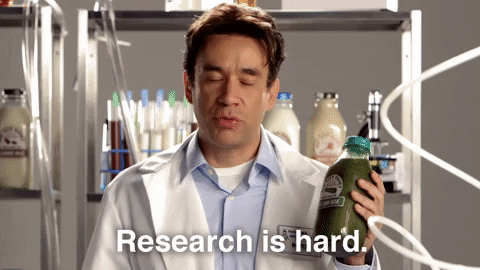This post originally appeared in the March 12, 2020 issue with the email subject line "My website redesign research process" and a review of writing software/word processor Ulysses.
Although they are on the internet, a magical place where some people still believe work happens for free, true website redesigns are neither fast nor cheap. A website programs many machines — which are not really that smart, you know — to present your content in a similar style across many contexts, for a variety of uses. That’s a hard task! If you receive any business awareness or activity from your content, a website redesign should involve significant research and planning for improved back-end and front-end performance.
What worked for your website in 2010 will likely not work in 2020 and beyond. If your website has been iterating and changing with user behavior over time, good for you! You must work at the New York Times. So glad to hear you’re not going anywhere!
But for the rest of you: a redesign is a significant effort. If you want to move beyond your homegrown Squarespace or WordPress website and invest in your website content, you’ll want to invest in research first. Researching user behavior and technical requirements will position your site to drive revenue from your content.

A content-centric website:
- Is designed to accommodate regularly published content across multiple media
- Takes at least two months, and more like six or eight, from start to finish
- Costs at least $10,000 (if you make more than $1M in revenue)
- Requires some kind of custom back-end work to ensure the site speed is fast
- Needs to be sustainable on the back end (authorship experience) as well as on the front end (user experience)
- Has massive return-on-investment and is a really fun process and not a headache, I promise
Beyond colors and fonts: The content-centric redesign
Content-driven redesigns laser focus on content presentation and sustainable growth. You may need to restructure how content is set up on the back end to prepare for future growth.
If you grow your business from readers and subscribers, you’ll need to research user needs and behaviors. Before embarking on a redesign, you should have a data-backed idea — and not just anecdotes or what you learned about design in college — of how your specific users interact with your website.
Even if you’ve worked with your audience for a long time, you still need to put in the work of research. Outside perspective is key for a redesign. You’ll likely find new opportunities to grow and better meet your users’ needs. You’ll identify new audiences who want to interact with your content. And you can’t define those in a two-hour meeting without talking to anyone outside your team.
My background in search/SEO and user experience has shaped the research process below. It differs from other content development processes because I’m not just sprinkling in keywords after content is developed — I’m basing my website and content development strategy on core findings from that search research. (Soapbox says: You can’t just “SEO your website” after the redesign is completed. Good search research should be the anchor for your website as a whole.)

To align teams on these data-backed ideas, I create a brief or strategy deck. The research is a process — anywhere between two and eight weeks — but it can save significant time in development costs and extend your time between redesigns. The research process creates a data structure and vision that can save you from another redesign two years down the line.
Following this process means that you will:
- Build a website that lasts 4-5 years as the foundation for your digital marketing or publication
- Be able to generate revenue from your website content — and not just through display ads, but actual membership or subscription revenue
- Save money on advertising over time. Good websites have content that is discoverable through organic means without the support of advertising
- Grow an audience who cares about what you have to say, which will create immense brand loyalty and sustain your business long-term
The UX/SEO/content-driven website research process
- Quick goals. In a quick stakeholder meeting (30-60 minutes), identify high-level internal goals. Figure out what you’re trying to accomplish with the website beyond updating look and feel. Some common goals:
- Implement a better subscription and revenue system
- Attract more traffic or improve organic search visibility
- Create a better experience for existing audiences
2. Search query research. Dive deep (deep!) how people are actually searching for your website, as well as identifying entities that Google likely identifies as related to your business. Some day I’ll go deep into my query research process, but for now start with Google Ads’ keyword planner or your preferred search research tool and work from there.

3. User survey. If you haven’t done an audience or user survey recently, now’s the perfect time. What do active users want to see? How do they use the site? Let them tell you. (I use Typeform, but there are many tools that can assist you with a survey.)
4. Performance analysis. What’s resonated with audiences in the past? What pages perform best in organic search or from direct sources? What’s not working or not being found? Keep this high level — you’ll be auditing in depth later.
5. Social listening. Do people talk about your business on Twitter, LinkedIn or forums? Now’s a good time to scour to see how people talk about topics related to your business. I use tools like Buzzsumo, Brand 24 and RivalIQ for this process.
6. Competitive research. I don’t go hog wild here, but I look at how competitors show up in search results and social. Have they already optimized their websites for search? What are they doing that resonates with customers (and how can we add more value)?
7. Audit. If your website is more than 50 pages, you’ll want to audit. Which content is the baby and which is the bathwater? Often in redesigns, some stakeholders say “everything sucks and it should all go.”

Sometimes that’s true, but more often websites have successful content hidden in an outdated design. If you’re getting steady traffic from organic search, it’s crucial to your redesign’s success that you maintain at least the idea of the high-performing content. Any pages that are ranking for any keywords above 30 in organic search results should be evaluated for quality and maintained in some form or another.
You may rewrite or revise your website’s current high performing content — but it still needs to be present on your new website to maintain search equity. To do this, you need to audit, page by page, and understand what has to stay, what can be revised or consolidated, and what content should be retired.
8. In-depth stakeholder interviews. With that research in your back pocket, it’s time to talk with stakeholders. You’ll want to talk with sales and marketing teams, technical and IT collaborators, as well as content production or editorial.
Basically, if a department depends on a website, you should spend at least 30 minutes talking with them about what they need the website to do and how they’ve observed users on the website. To avoid the trap of a “here’s everything wrong with our website” complaint session, come prepared specific questions. In this stage, I spend time with people who input the content to find out how they’re trained on content production and identify where we can add efficiencies.
9. Technical requirements. How is the database currently set up? Where is audience data stored? How does the content management system integrate with email and social media? What’s the site speed like? Is the current server setup working? Is the website secure? Is Google seeing the website the way it’s meant to be seen? All of these questions will need to go into the brief or RFP documents for developers.
From all of these steps, I create a brief or a strategy deck, depending on the size and needs of the project.
Hand-picked related content







